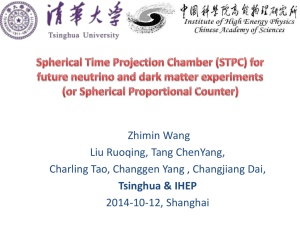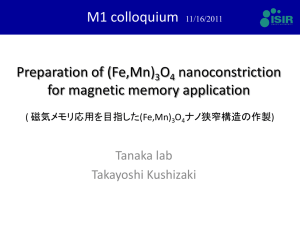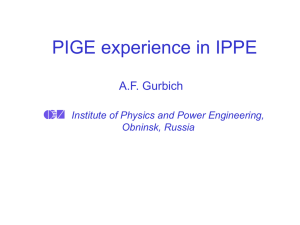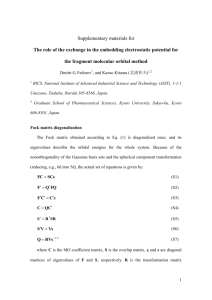Document
advertisement
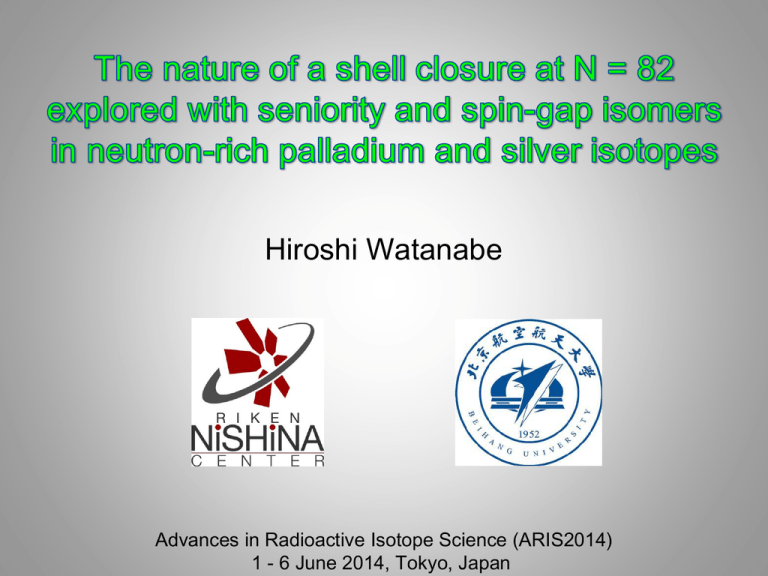
Hiroshi Watanabe Advances in Radioactive Isotope Science (ARIS2014) 1 - 6 June 2014, Tokyo, Japan Collaborators of EURICA campaign in 2012 H. Baba, G. Benzoni, F. Browne, P. Doornenbal, N. Fukuda, G. Gey, N. Inabe, T. Isobe, H-S. Jung, A. Jungclaus, D. Kameda, I. Kojouharov, F.G. Kondev, T. Kubo, S. Kubono, N. Kurz, G.J. Lane, Z. Li, G. Lorusso, A. Montaner, C-B. Moon, K. Moschner, F. Naqvi, M. Niikura, H. Nishibata, S. Nishimura, D. Nishimura, A. Odahara, Z. Patel, Z. Podolyak, E. Sahin, H. Sakurai, H. Schaffner, Y. Shimizu, G. Simpson, P.A. Söderström, K. Steiger, T. Sumikama, H. Suzuki, H. Takeda, J. Taprogge, Z. Vajta, H. Watanabe, J. Wu, Z. Xu, A. Yagi, K. Yoshinaga Theoretical support T. Otsuka, K. Ogawa, K. Kaneko, Y. Sun RIKEN Nishina Center, Biehang University, INFN, University of Brighton, University of Joseph Fourier, Chung-Ang University, University of Madrid, GSI, Argonne National Laboratory, Australian National University, Peking University, Instituto de Fisica, Hoseo University, University of Koeln, Yale University, University of Tokyo, Osaka University, Tokyo University of Science, University of Surrey, University of Oslo, Grenoble, TU Munich, Tohoku University, University of Debrecen New magic numbers N = 16, 32, 34 20 8 Shell quenching N = 8, 20, 28, (40) 28 20 8 ? 126 ? 82 Proton T1/2 [s] ? 50 Neutron Does the shell quenching take place at the heavier magic numbers, 50, 82 …? 51 130Sb 131Sb 132Sb 133Sb 134Sb 50 129Sn 130Sn 131Sn 132Sn 133Sn 49 128In 129In 130In 131In 132In 48 127Cd 128Cd 129Cd 130Cd 131Cd 47 126Ag 127Ag 128Ag 129Ag 130Ag 79 80 81 82 83 f7/2 d3/2 h11/2 s1/2 d5/2 g7/2 82 50 g9/2 p1/2 High-j orbitals, νh11/2 and πg9/2, play important roles in forming nuclear levels π-π ν-ν Seniority scheme ⇒ probe of shell closure 51 130Sb 131Sb 132Sb 133Sb 134Sb 50 129Sn 130Sn 131Sn 132Sn 133Sn 49 128In 129In 130In 131In 132In 48 127Cd 128Cd 129Cd 130Cd 131Cd 47 126Ag 127Ag 128Ag 129Ag 130Ag 79 80 81 82 83 Seniority scheme ⇒ probe of shell closure Monopole ⇒ shift SPE Multipole ⇒ split multiplet 82 50 g9/2 p1/2 ν-ν π-ν f7/2 d3/2 h11/2 s1/2 d5/2 g7/2 π-π High-j orbits, νh11/2 and πg9/2, play important roles in forming nuclear levels 130In T. Otsuka et al., PRL 104, 012501 (2010) Spin trap Layout of the entire experimental setup 12 Clusters (7 Ge each) “EURICA” SRC BigRIPS 238U beam (345 AMeV) 8 DSSSDs (60×40 each) “WAS3ABi” γ Identification and further separation Be target Separation of RI beam Z A/Q β RI Experimental result (Ⅰ) Seniority isomer in 128Pd82 Isomer Delayed coin. with 128Pd ions (Δt=0.15-25 μs) H. Watanabe et. al., Phys. Rev. Lett. 111, 152501 (2013) γ-γ coincidence with a gate on 1311 keV B(E2;8+→6+) Seniority (ν) scheme 2 2 j 1 2n 2 eeff B( E 2; J J 2) 2 j 1 2 128Pd 82 Good ν=2 in the well isolated πg9/2 subshell Robust shell closure at N=82 Experimental result (Ⅱ) Isomeric states in 126Pd80 Isomer Delayed coincidence with 126Pd ions (Δt = 0.15-5 μs) γ-ray singles γ-γ coincidence with a gate on 542 keV Time relative to beam Time difference Two isomers lie at 2110 and 2023 keV 126Pd 80 Within 50 ms after implantation of 126Pd ions Coincidence with electrons: -0.5 ≦ Δteγ ≦ 0.5 μs (prompt) -4.0 ≦ Δteγ ≦ 0.5 μs (early) -0.5 ≦ Δteγ ≦ 50 μs (delayed) Electron spectrum: Gate on γ rays below 5Without γ-ray gate 86 keV IC Gate on 86-keV IC ⇒ A new γ ray at 297 keV H. Watanabe et. al., submitted 126Pd 80 Long-lived isomer Ex = 2406 keV T1/2 = 23.0(8) ms Jπ = (10+) 126Pd 80 Rint = 26(8) % B(E3) = 0.07(2) W.u. T1/2 average 20.4(13) ms 25.1(10) ms 48.6(8) ms 126Ag 79 1.5 E (10 ) E (7 ) 1.0 Energy [MeV] N=80 isotone • 7- : ν(h11/2-1d3/2-1) • 10+ : ν(h11/2)-2 0.5 E (11 / 2 ) E (3 / 2 ) 0.0 -0.5 d5/2 -1.0 g7/2 Mo Ru Pd Cd Sn Te Xe Ba Ce πg7/2 For Z > 50, E(11/2-) decrease as Ce → Sn N=81 isotone • 3/2+ : νd3/2-1 • 11/2- : νh11/2-1 82 d3/2 50 g9/2 Proton h11/2 s1/2 Neutron Monopole interaction between πg7/2 (+ πd5/2) and νh11/2 Similar trend for E(10+)- E(7-) : Good probe for the evolution of shell orbits 1.5 E (10 ) E (7 ) 1.0 Energy [MeV] N=80 isotone • 7- : ν(h11/2-1d3/2-1) • 10+ : ν(h11/2)-2 0.5 E (11 / 2 ) E (3 / 2 ) 0.0 Central only -0.5 Central+Tensor -1.0 VMU For Z < 50 πg9/2-νh11/2 monopole 82 d5/2 g7/2 Mo Ru Pd Cd Sn Te Xe Ba Ce πg9/2 N=81 isotone • 3/2+ : νd3/2-1 • 11/2- : νh11/2-1 d3/2 50 g9/2 Proton h11/2 s1/2 Neutron VMU: monopole-based universal interaction T. Otsuka et al., Phys. Rev. Lett. 104, 012501 (2010) Central only ⇒ 11/2- energy rapidly decreases + Tensor ⇒ Suppress the upward drift of νh11/2 1.5 E (10 ) E (7 ) 1.0 Energy [MeV] N=80 isotone • 7- : ν(h11/2-1d3/2-1) • 10+ : ν(h11/2)-2 128Cd 126Pd 0.5 130Sn E (11 / 2 ) E (3 / 2 ) 0.0 Central only -0.5 Central+Tensor -1.0 VMU For Z < 50 πg9/2-νh11/2 monopole 82 d5/2 g7/2 Mo Ru Pd Cd Sn Te Xe Ba Ce πg9/2 N=81 isotone • 3/2+ : νd3/2-1 • 11/2- : νh11/2-1 d3/2 50 g9/2 Proton h11/2 s1/2 Neutron VMU: monopole-based universal interaction T. Otsuka et al., Phys. Rev. Lett. 104, 012501 (2010) Central only ⇒ 11/2- energy rapidly decreases + Tensor ⇒ Suppress the upward drift of νh11/2 Smaller energy difference between the 10+ and 7- states in 126Pd can be explained by the monopole interaction including the central and tensor effects 1.5 Energy [MeV] 1.0 0.5 N=80 isotone • 7- : ν(h11/2-1d3/2-1) • 10+ : ν(h11/2)-2 E (10 ) E (7 ) ±0 MeV 128Cd 126Pd 130Sn -0.1 MeV E (11 / 2 ) E (3 / 2 ) 0.0-0.2 MeV -0.5 -1.0 Monopole corrections for the πg9/2-νh11/2 TBME in SM g7/2 Shell-model calculation d3/2 50 g9/2 E(10+)- E(7-) shows “kink” at Z=48 (128Cd) 82 d5/2 Mo Ru Pd Cd Sn Te Xe Ba Ce πg9/2 N=81 isotone • 3/2+ : νd3/2-1 • 11/2- : νh11/2-1 Proton h11/2 s1/2 Neutron Other multipole components must be introduced in a shell-model framework 132Sn core, Z=28-50, N=50-82 model space TBME: p-p, n-n (SDI) p-n (Yukawa type) + monopole corrections for πg9/2-νh11/2 For Z < 50, E(10+)-E(7-) sensitive to the monopole part of the πg9/2-νh11/2 TBME Experimental result (Ⅲ) Spin-gap isomer in 127Ag80 and its decay properties Isomer β-decay from 127Ag to 127Cd 739, 821 keV gate 242 keV gate (19/2+) (23/2+) 306 keV gate ns, μs isomers 127Ag internal decay Electron spectrum (687, 773, 262 keV gate) Decay via E3 and β-decay Jπ = (27/2+), Ex ~ 1950 keV 739, 821 242, 306 687 Decay via E3 and β-decay Jπ = (27/2+), Ex ~ 1950 keV T1/2 = 63.2(5) ms B(E3) = 0.32(3) W.u. πg9/2-1 νh11/2-2 πg9/2-1 νh11/2-2 πg9/2-1 νh11/2-1d3/2-1 GT GT νg7/2-1h11/2-1d3/2-1 νg7/2-1 h11/2-2 νd3/2-1 h11/2-2 GT level with νg7/2-1 ~0.6 MeV lower in 127Cd than in 129Sn Upward drift of the νg7/2 orbital in the N = 50-82 shell Summary Isomeric states in neutron-rich 46Pd and 47Ag isotopes have been studied as part of the EURICA U-beam campaign in 2012 128Pd 82 T1/2 = 5.8(8) μs, Eex = 2151 keV, Jπ = (8+) Good seniority as a result of the robust shell closure at N = 82 126Pd 80 T1/2 = 0.33(4) μs, Eex = 2023 keV, Jπ = (5-) T1/2 = 0.44(3) μs, Eex = 2110 keV, Jπ = (7-) T1/2 = 23.0(8) ms, Eex = 2406 keV, Jπ = (10+) Small energy difference between the 10+ and 7- isomers, explained by the p-n monopole interaction including the central and tensor forces 127Ag 80 T1/2 = 63.2(5) ms, Eex = ~1950 keV, Jπ = (27/2+) Lowering the GT level due to the monopole drift of the νg7/2 orbital β-decay of 127Pd Decay via E3 and β-decay Jπ = (27/2+), Ex ~ 1950 keV T1/2 = 63.2(5) ms B(E3) = 0.32(3) W.u.


